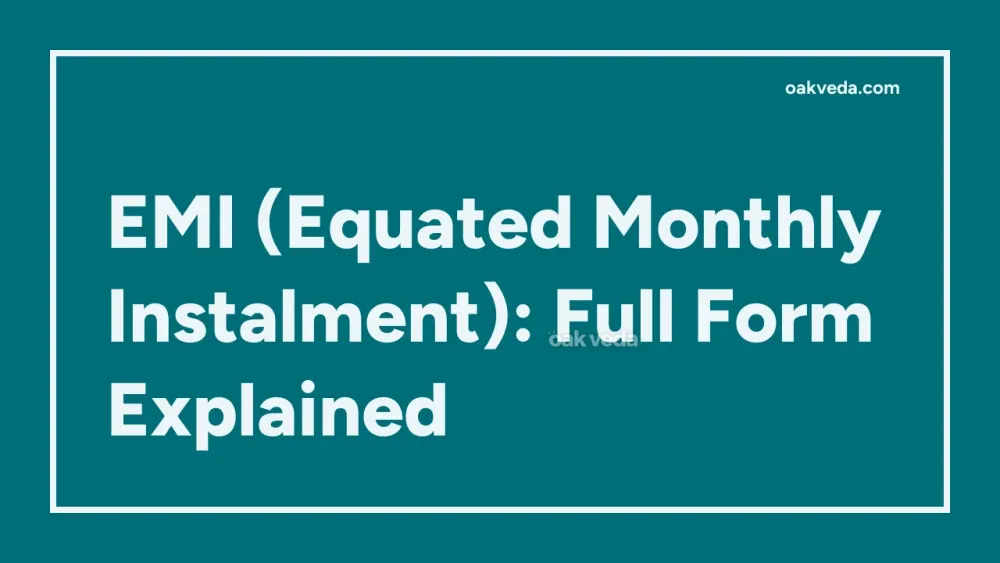
What is the Full Form of EMI?
The full form of EMI is Equated Monthly Instalment. This financial term is widely used in the context of loans and repayment schedules, particularly for mortgages, personal loans, and vehicle loans.
What is Equated Monthly Instalment?
An Equated Monthly Instalment, commonly known as EMI, is a fixed amount that a borrower pays to a lender at a specified date each month. This payment system is designed to simplify loan repayments by dividing the total amount owed into equal monthly payments over the loan tenure.
Origin and Development of Equated Monthly Instalment
The concept of EMI has been around for decades, evolving alongside the modern banking and lending industry. It was developed to make loan repayments more manageable for borrowers while ensuring lenders receive regular payments. The EMI system has become increasingly sophisticated with the advent of digital banking and financial technology.
How does Equated Monthly Instalment work?
EMIs work by combining two key components:
- Principal Amount: This is the original sum borrowed from the lender.
- Interest: The cost charged by the lender for providing the loan.
Each EMI payment includes a portion of both the principal and the interest. Initially, a larger part of the EMI goes towards interest, but as the loan tenure progresses, more of each payment is applied to the principal.
The calculation of EMI depends on several factors:
- Principal amount borrowed
- Interest rate
- Loan tenure
- Repayment frequency (usually monthly)
Lenders use a specific formula to calculate EMIs, ensuring that the loan is fully repaid by the end of the tenure.
Types of Equated Monthly Instalments
While the basic concept remains the same, there are variations in EMI structures:
- Fixed EMI: The most common type, where the instalment amount remains constant throughout the loan tenure.
- Step-up EMI: The instalment amount increases over time, usually aligned with expected income growth.
- Balloon EMI: Lower regular payments with a large final payment at the end of the loan term.
- Flexible EMI: Allows borrowers to adjust their payment amount based on their financial situation.
Functions of Equated Monthly Instalment
EMIs serve several important functions in the lending ecosystem:
- Simplify Repayments: By breaking down large loan amounts into manageable monthly payments.
- Ensure Regular Cash Flow: Provide lenders with a steady stream of repayments.
- Budget Planning: Help borrowers plan their monthly expenses more effectively.
- Risk Management: Reduce the risk of default by spreading repayments over time.
Applications of Equated Monthly Instalment
EMIs are widely used in various financial products and services:
- Home Loans (Mortgages)
- Personal Loans
- Auto Loans
- Education Loans
- Consumer Durable Loans
- Business Loans
Features of Equated Monthly Instalment
Key features of EMIs include:
- Fixed Payment Amount: Consistent monthly payments for easier budgeting.
- Interest and Principal Components: Each payment includes both interest and principal repayment.
- Flexibility: Some lenders offer options to adjust EMI amounts or prepay loans.
- Automated Payments: Often set up through direct debits or standing instructions.
- Transparency: Clear breakdown of principal and interest components in each payment.
Benefits of Equated Monthly Instalment
EMIs offer several advantages to both borrowers and lenders:
- Affordability: Allows individuals to make large purchases by spreading the cost over time.
- Predictability: Fixed monthly payments help in financial planning.
- Easier Approval: Regular repayments can make loan approval more likely.
- Interest Savings: Early payments or higher EMIs can reduce overall interest paid.
- No Intermediaries: Direct payments to lenders simplify the process.
- Credit Building: Regular, timely EMI payments can improve credit scores.
Limitations or Challenges of Equated Monthly Instalment
While EMIs are beneficial, they also have some drawbacks:
- Long-term Commitment: Can tie up finances for extended periods.
- Interest Costs: Total interest paid over the loan tenure can be substantial.
- Inflexibility: Fixed payments may be challenging during financial difficulties.
- Prepayment Penalties: Some loans may charge fees for early repayment.
- Complex Calculations: Understanding EMI structures can be challenging for some borrowers.
Future Developments in Equated Monthly Instalment Technology
The future of EMIs is likely to see several innovations:
- AI-Driven EMI Calculations: More personalized EMI structures based on individual financial profiles.
- Blockchain Integration: Improved transparency and security in EMI transactions.
- Dynamic EMIs: Real-time adjustments based on borrower's financial situation.
- Integration with Financial Planning Apps: Seamless incorporation of EMIs into overall financial management.
- Voice-Activated EMI Management: Using smart assistants to manage and track EMI payments.
FAQs on EMI Full Form
-
What factors affect EMI calculation? EMI calculation depends on the principal amount, interest rate, loan tenure, and repayment frequency.
-
Can I change my EMI amount during the loan tenure? Some lenders offer flexibility to adjust EMI amounts, but this often depends on the loan terms and conditions.
-
Is it better to choose a longer tenure with lower EMIs or a shorter tenure with higher EMIs? This depends on your financial situation. Longer tenures mean lower EMIs but higher total interest paid, while shorter tenures have higher EMIs but lower overall interest costs.
-
How does prepayment affect EMIs? Prepayments can either reduce the loan tenure while keeping EMIs constant or lower the EMI amount while maintaining the original tenure.
-
Are EMIs calculated differently for different types of loans? The basic EMI calculation remains the same, but factors like interest rates and tenures may vary depending on the loan type.
Understanding the full form and concept of EMI is crucial for anyone considering taking a loan. By grasping how Equated Monthly Instalments work, borrowers can make informed decisions about their financial commitments and manage their repayments more effectively.
You may be interested in:

